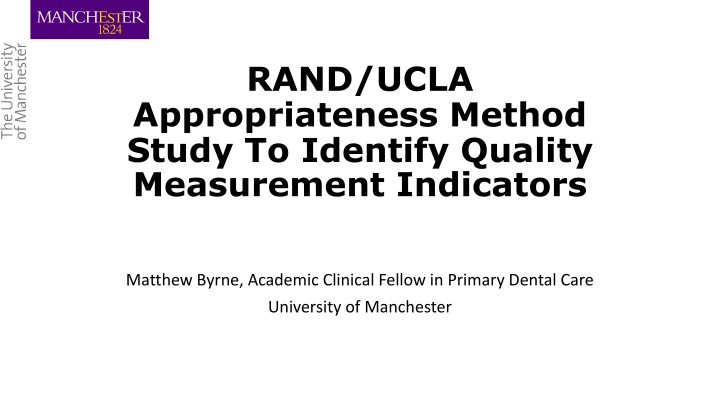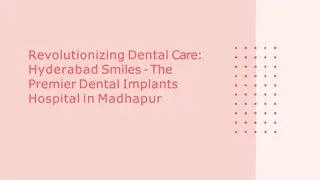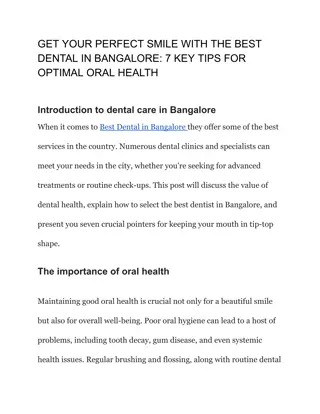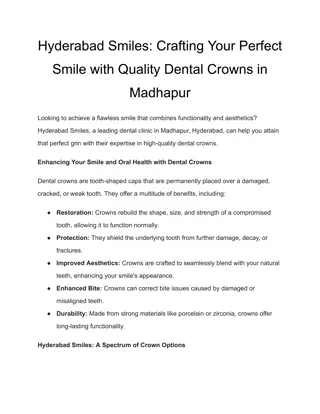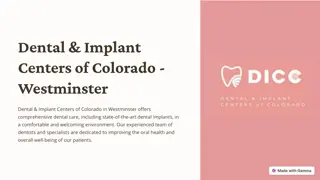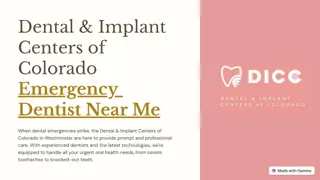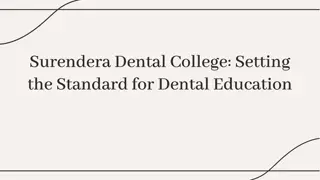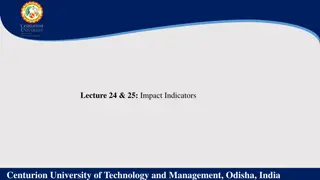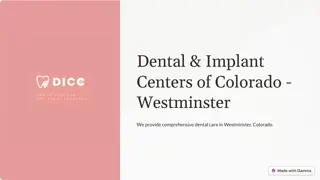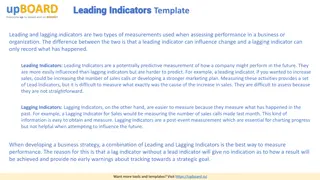Study on Identifying Quality Measurement Indicators in Primary Dental Care
This study by Matthew Byrne, an Academic Clinical Fellow at the University of Manchester, focuses on identifying quality measurement indicators for primary dental care. The aims include gaining consensus on important quality dimensions, assessing available quality measures, and identifying areas for further quality measure development. The method involves a RAND Clarity Consensus exercise to validate measures, rating clarity and necessity, and determining feasibility. The study aims to inform the definition of quality in dentistry and establish a core set of quality indicators.
Download Presentation

Please find below an Image/Link to download the presentation.
The content on the website is provided AS IS for your information and personal use only. It may not be sold, licensed, or shared on other websites without obtaining consent from the author.If you encounter any issues during the download, it is possible that the publisher has removed the file from their server.
You are allowed to download the files provided on this website for personal or commercial use, subject to the condition that they are used lawfully. All files are the property of their respective owners.
The content on the website is provided AS IS for your information and personal use only. It may not be sold, licensed, or shared on other websites without obtaining consent from the author.
E N D
Presentation Transcript
RAND/UCLA Appropriateness Method Study To Identify Quality Measurement Indicators Matthew Byrne, Academic Clinical Fellow in Primary Dental Care University of Manchester
Background Dimensions of Quality Patient- centred Safe Effective Timely Efficient Equitable ??? Indicator Structure Domains of Quality Process Indicator Indicator Outcome
Aims 1) To gain consensus on the dimensions of quality that are important for Primary dental care to inform a definition of quality for dentistry; 2) To assess the currently available quality measures and to aim to gain consensus on quality measures that are clear, necessary and feasible for construction a core set of quality indicators 3) To identify the dimensions and domains of quality where further development of quality measures is required. 4) To identify measures that require further development to allow them to be used as quality indicators.
Identifying core measures - RAND Clarity Consensus forming exercise to gain face validity on measures. Previously used in development of the GP QOF Indicators describe a clear target population 2 Rounds of rating (Online, then face to face) Quantifies how necessary, clear and feasible measures are and gives indication of agreement Necessity Indicators derived from robust evidence base and describe aspects of care necessary to Existing Measures from grey and peer reviewed literature identified in systematic review Dimensions of quality outside of IoM definition identified through literature search Feasibility Indicators that are feasible to measure in general practice and do not detract from the normal working practices of the GDP
Methods Round 1 Rating 1-3 4-6 7-9 Indicator was unclear and could not be developed Further development of clarity the indicator was required. Indicator was clear and needed little or no development Clarity Panel Comprising GDPs, secondary care and Public Health consultants Actions measured unnecessary for the provision of quality care Necessity of the action measured by indicator was unclear Actions measured are absolutely necessary in the provision of quality care Necessity First round: Online rating of 247 quality measures and 19 Dimensions of quality Clarity and Necessity rated in online questionnaire 1-9 scale. Rating considering an average dentist providing care in an average practice to average patients in England. Scores compiled and Median rating and Disagreement index calculated (Interpercentile range adjusted for symmetry) In current circumstances, the indicator was infeasible to measure Indicator may be feasible to introduce but would require changes to systems and processes. Measure could be easily implemented with little modification to systems and process Feasibility Disagreement index >1 = Disagreement <1 = Agreement Median 7 and DI<1 = Agreement of clarity, necessity or feasibility
Methods - Round 2 Face to Face meeting Each participant received a personalised rating sheet to re rate indicators Their own 1st round rating Distribution of other participants rating Moderator had moderation sheet Median Score, Disagreement index Each participants first round response The role of the moderator was to guide discussion and highlight points of disagreement from first round to aid the formation of consensus. Rewording of indicators Data collected into Excel Median scores and disagreement index (IPRAS technique) was calculated. Excerpt of Participant sheet Frequency of other participants responses from first round Excerpt of moderator sheet Frequency, median, disagreement index
Methods: Possible outcomes Median Score Disagreement index Interpretation 1-3 <1 Consensus that measure is unclear, unnecessary or infeasible 4-6 <1 Consensus that clarity, necessity or feasibility is uncertain 7-9 <1 Consensus on clarity, necessity or feasibility Any score >1 Disagreement For a measure to be included Agreement must be met on Clarity, necessity and Feasibility I.e.: Median 7 and DI<1
Results - Dimensions of Quality Clarity Median Disagreement Index Equity 7 0.11 Efficiency 7 0.39 Timeliness 7 0.24 Safety 9 0.11 Effectiveness 7 0.24 Patient Centeredness 7 0.24 Caring function 5 0.24 Appropriateness 7 0.11 Relevance 2 0.39 Optimality 3 0.58 Legitimacy 2 0.24 Acceptability 5 0.24 Technical Quality 8 0.24 Comprehensive 7 1.12 Continuity of care 7 0.58 Empathetic 7 0.39 Responsive 8 0.11 Tangibility 5 0.24 Accessibility 7 0.11 Necessity Dimension Agreement Clear Clear Clear Clear Clear Clear Uncertain Clear Unclear Unclear Unclear Uncertain Clear Disagreement Clear Clear Clear Uncertain Clear Median 8 9 8 9 8 8 7 8 5 6 4 6 8 8 8 7 7 7 7 Disagreement Index 0.24 0.24 0.11 0 0.11 0.24 0.24 0 0.39 0.11 0.24 0.24 0 0.24 0.11 0.11 0.24 0.24 0.11 Agreement Necessary Necessary Necessary Necessary Necessary Necessary Necessary Necessary Uncertain Uncertain Uncertain Uncertain Necessary Necessary Necessary Necessary Necessary Necessary Necessary Include? YES YES YES YES YES YES NO YES NO NO NO NO YES NO YES YES YES NO YES Dimensions IoM Further Dimensions from literature
Results Quality measures Ratings of Indicators Ratings of Indicators Panel: 6 GDPs with experience ranging from 3-34yrs 2 practice principals 4 associates 1 consultant in restorative dentistry 1 consultant in dental public health 1 regional dental dean 260 quality indicators were rated in the second round 21 rewordings offered by the panel at the face to face meeting. 101 were indicators of structure, 85 of process 74 of outcomes. 79 Indicators Rated Median 7 with DI <1 for Clarity, Necessity and Feasibility were included 45 Composite measures constructed though iterative discussion of the measures between the authors in order to avoid unnecessary overlap between the measures. Indicators rated as Unneccesary 29 107 Indicators Rated as Clear, Necessary and Feasible 45 Indicators Rated as Clear, Necessary but with Uncertain Feasiblity 79
Indicators Dimensions of Quality Patient- centred Safe Effective Timely Efficient Equitable 5 4 3 0 1 1 Structure n=14 Domains of Quality 415 4 2 2 0 Process n=26 5 Outcome n=5 0 0 0 0 0
Composite Indicators Rated Clear, Necessary and Feasible Structure n=14 Focus on safety and efficiency Safety of buildings, accessibility, infection control appropriate training of staff Process n=26 Focus on Effectiveness Correct prescription of prevention Fluoride Reflects clinical guidance Detailed pocket charts with BPE3 and 4 Proper recording of risk assessments Clinical records Outcome n=5 All regarding effectiveness Failure of restorations Adaptation of margins
Conclusions The RAND/UCLA process is a feasible method for rating quality measures for PDC that may be repeated in a number of different contexts. Consensus on the appropriateness of the dimensions of quality described by the IoM definition was reached. The high rating of dimension of Technical quality suggests this may be required in a definition of quality for PDC. Few measures of clinical outcomes emerged from this process. Most measures of outcome addressed restoration survival. Further measure development is required to populate a comprehensive measurement suite. A number of process measures were rated as clear, necessary and feasible that may be derived from inspection of an electronic health records, suggesting potential for automatic quality measurement. Many current indicators were deemed to be unnecessary
